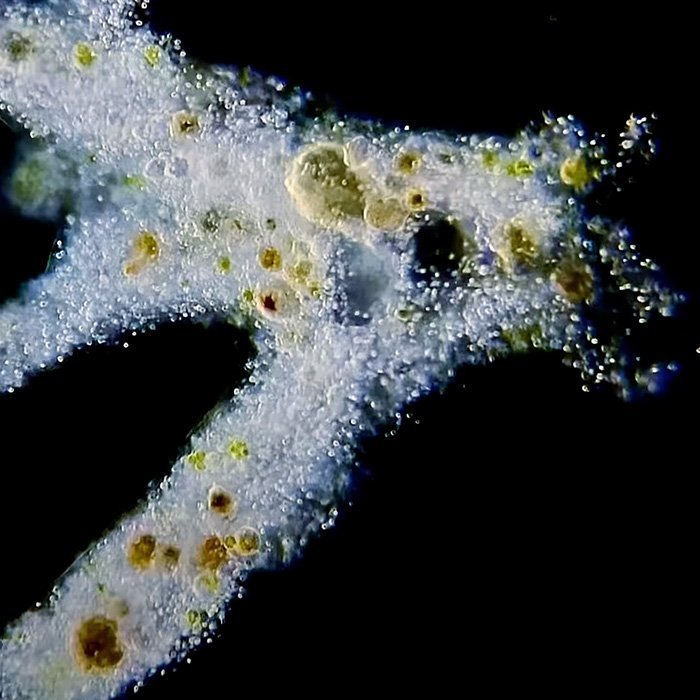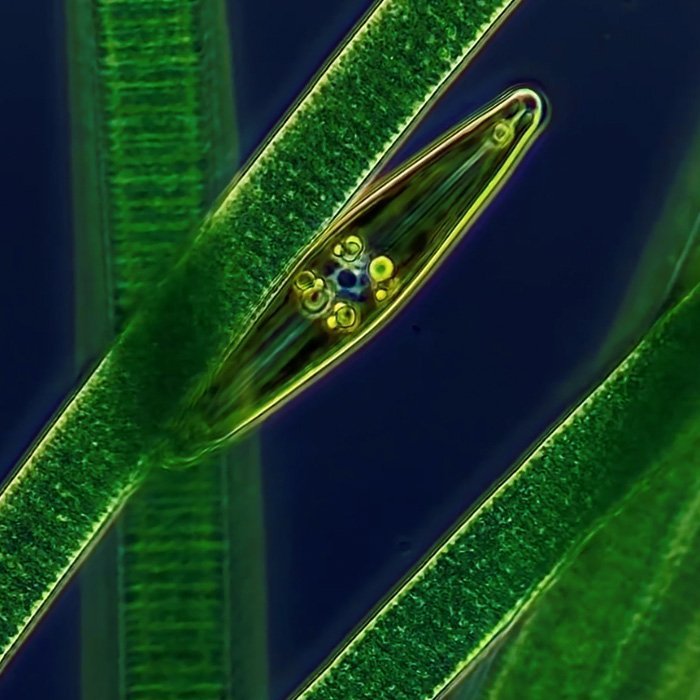The microbiologist blowing up Instagram with her close up videos of tardigrades
Chloé Savard is a microbiology student based in Tiohtià:ke, Montreal who swapped making music for a life peering into a microscope just two years ago. Her obsession with miniscule marine organisms led her to start archiving her work on Instagram and TikTok under the name @tardibabe, introducing the internet to aquatic life that’s impossible to see with the naked eye.
With no expectations that she’d find an audience for her biological explorations, her videos shot on iPhone of kaleidoscopic tardigrades, neon nematodes and shimmering algae, dancing and wriggling on petri dishes, have captivated the online science community and beyond.
Savard’s enthusiasm for her work and detailed explanations of the organisms that she’s analyzing is infectious. We spoke to her about the impact that her research has had on her mental wellbeing, microplastics, how and where she collects her samples, and why she adores marine diatoms.
“Diatoms are a type of photosynthetic, single-celled microalgae made of glass that can be found in every aquatic ecosystem around the globe. They can even be found in soil! Not only do they produce around 20% to 30% of the oxygen we breathe every year but they also constitute the major part of marine phytoplankton, making them a critical link at the bottom of the food chain.”
Chloé Savard
Q & A with Chloé Savard
When did your fascination with microbiology and water begin?
I have had a strong interest in biology since I was a kid but it was only after seeing microscopy videos on Instagram that I completely fell in love with this tiny universe! I bought myself a cheap microscope two years ago and made videos during my free time. Little did I know how big of an impact it would have on my life; it helped me with depression, chronic pain, expressing my creativity, learning new stuff and finding meaning to life on earth! I had been studying music for years before deciding to get into the biology program and then microbiology program and I must admit that it was one of the best decisions I ever made.
How do you collect the organisms that you're inspecting? Are there particular places that you like to visit?
I collect them from lots of different places like ponds, swamps, lakes, rivers and streams but I also take samples from mosses and lichens to find tardigrades. I love to visit and sample new places because it usually means new organisms I’ve never seen before! During winter though, you can see me sampling from aquariums at my local pet store (with the staff’s approval, of course). I can keep freshwater samples for weeks and see how population dynamics change over time, it’s fascinating!
Tell me about marine diatoms and give them the credit they deserve!
Diatoms are a type of photosynthetic, single-celled microalgae made of glass that can be found in every aquatic ecosystem around the globe. They can even be found in soil! Not only do they produce around 20% to 30% of the oxygen we breathe every year but they also constitute the major part of marine phytoplankton, making them a critical link at the bottom of the food chain. They get preyed on by zooplankton, often small crustaceans and other little animals, which get preyed on by fish, birds and whales.
When diatoms die, they sink at the bottom of the sea and they’re either dissolved by bacteria or they accumulate with the remains of millions of other diatoms. This massive diatom deposit is known as diatomaceous earth and is used in various industries to make toothpastes, metal polishers, insect repellents and is even used for liquid filtration in sugar refineries!
How often do you find microplastics in your work, and what does that say to you about the state of our planet?
I find microplastics in all of my samples and that’s very alarming. I also find some in various foods! Unfortunately, contaminants like microplastics or harmful chemicals can be transferred from bottom up in the food chain.
Toxic metals, chemicals and microplastics are released from industrial, urban and agricultural sources where they make they’re way into different water bodies and infiltrate the food chain. It’s no big surprise that microplastics have been found in human blood along with other toxins like mercury which can attach to red blood cells and cause diseases. This reflects well how the health of our planet is declining and should encourage us to change our lifestyle.
Is there an organism that you've found that you particularly love, and why?
That’s a very tough one! I tend to fall in love with lots of different organisms because they’re all so unique and beautiful in their own way. The ciliate Nassula hypnotizes me with their kaleidoscopic cytoplasm flow, water bear make my heart melt with their cute piglet mouth and small claws, Volvox algae could spin around for days and I wouldn’t get tired watching them and rotifer species exhibit such diversity in their different morphologies that they’ll never cease to surprise me!
When did you make the decision to start documenting your work on IG and TikTok, and were you surprised at how popular it became?
I started my IG page two years ago and my TikTok one year ago. I didn’t have any expectations so I’m overwhelmed with joy to see how people are invested in the content I create.
In your work have you seen any evidence of climate change affecting the species that you inspect?
I haven’t seen much change in only two years of sampling but it’s something I’ll keep my eyes on during the next decades!
How big is the tardigrade loving community? Are there a lot of other like minded microbiologists who love water bears that you've met through your work?
The tardigrade loving community is HUGE! From musicians to 3D artists, cartoonists, scientists, science-fiction fans, videogame creators, poets… the list goes on and on! It’s no coincidence that I chose ‘’tardibabe’’ as my IG name because I knew it would bring all types of people together. Most of the microbiologists and microscopists I’ve met adore tardigrades as much as I do (I mean, it would be hard not to) and I’ve learned a lot about them through these people. I’m very lucky and grateful!


















